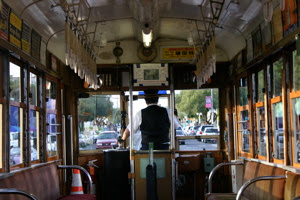
TRAX is the first of two light rail systems I will visit during my trip. Surprisingly, Phoenix does not have such a system though one is under construction and due to open in December of 2008. BTW, the term light rail doesn't have anything to do with the weight of the rail, rather the amount of traffic it carries or the type of car it uses depending on what definition you use. TRAX has two lines, I rode them both. One goes east to the University of Utah and it's medical center, the other goes south to the city of Sandy. The trip to Sandy however never leaves an urban area. There is also a route that connects Sandy and the university, diverting from one line to the other at the place where they meet up and not requiring a transfer. It runs infrequently and I didn't get to ride that route. They have plans for considerable light rail expansion, and a "heavy rail" commuter line north to Ogden so the system must be rather successful. The train I rode south was coupled to a waiting train at Sandy so the trip north was on an impressively long consist of four articulated cars, giving the impression of an eight car train. Since we were headed into town on an afternoon train, the eight cars were pretty empty but they were ready for the rush hour to begin. BTW, that building in the background of the picture is the Grand American Hotel. It's quite impressive up close.
The track south, though in an urban area, appears to have originally been a freight railroad. In fact there are spurs off of the main line leading into warehouses and other plants with freight cars spotted on them so it must still be used for freight operations at night.



























